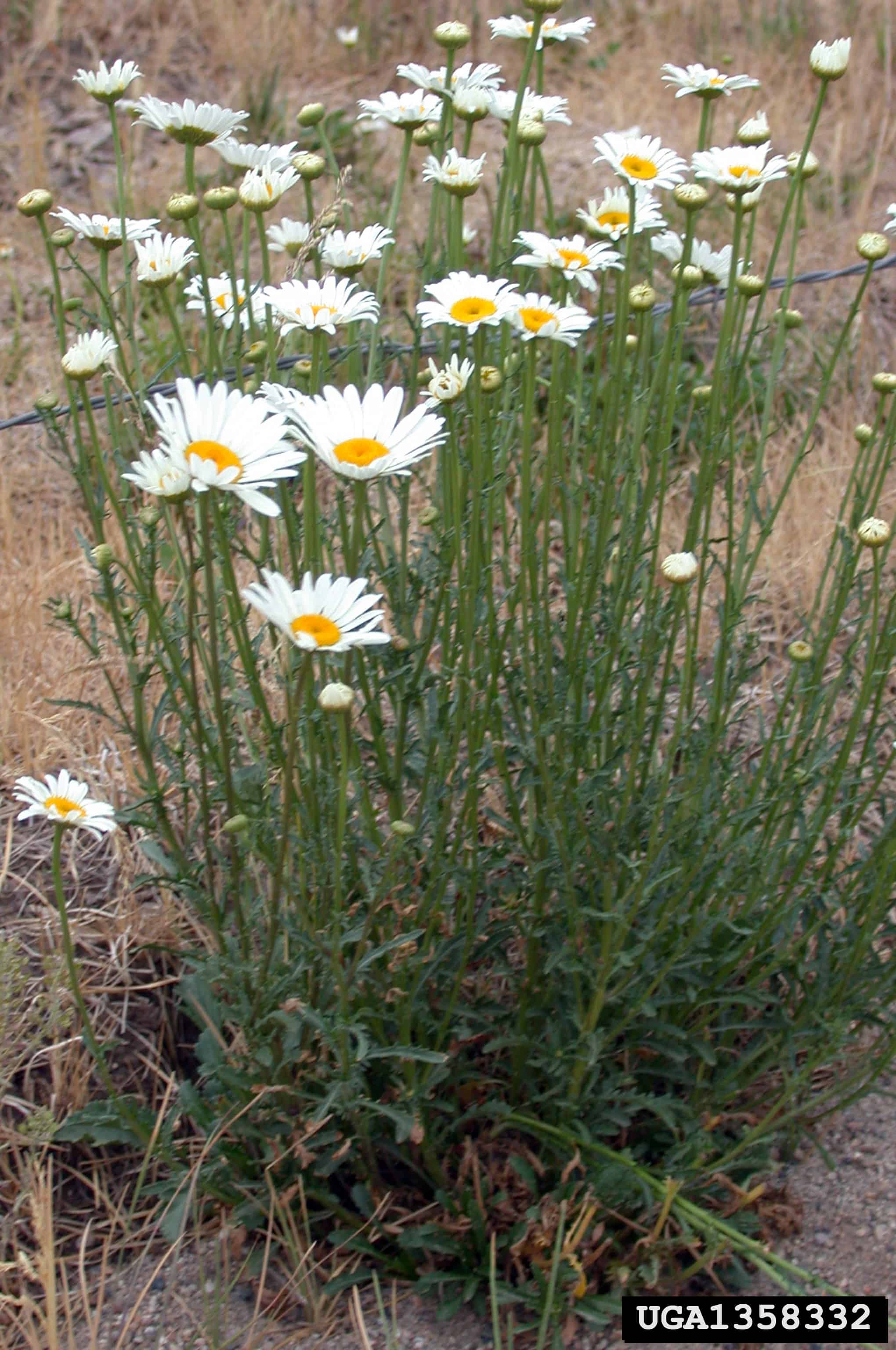Leucanthemum vulgare
Overview
Aperçu
Regulation :
Remarques Réglementation:
- CFIA Weed Seeds Order - Class 3: Secondary Noxious Weed Seeds
- CFIA Weed Seeds Order - Class 5: Noxious Weed Seeds
Regulation Notes:
Distribution :
Répartition :
Native to Europe and western temperate Asia (USDA-ARS 2020). Naturalized in east and southern Africa, eastern temperate and southern tropical Asia, Australia, New Zealand, North America and parts of South America (USDA-ARS 2020). Occurs in all Canadian provinces and territories (Brouillet et al. 2010+).
Habitat and Crop Association :
Habitat et Cultures Associées :
Cultivated land, hayfields, pastures, gardens, lawns, rangeland, native grasslands, forest openings, abandoned croplands, roadways, railway embankments and disturbed areas (Darbyshire 2003; Clements et al. 2004).
Economic Use, cultivation area, and Weed Association :
Utilisation économique, zone de culture et association de mauvaises herbes :
Duration of Life Cycle :
Durée du cycle vital:
Perennial
Dispersal Unit Type :
Type d’unité de dispersion :
Achene
General Information
RENSEIGNEMENTS GÉNÉRAUX
Leucanthemum vulgare was introduced to North America as an ornamental and seed contaminant in the late 1700s. By 1800, it was well established in many areas of North America (Clements et al. 2004).
Reproduction occurs mainly through seeds but plants can also sprout from underground stems (Clements et al. 2004). A single plant may produce several thousand seeds per season that can remain viable in the soil for 5 to 40 years (Clements et al. 2004).
.
Leucanthemum vulgare infestation in Prince Albert National Park, Saskatchewan, Canada (Canadian Food Inspection Agency)
Identification
Identification
-
Achene
Size
- Achene length*: 1.3 – 2.2 mm; width: 0.6 – 1.0 mm
*Note: minimum and maximum of 10 achenes in a normal range of this species using image measurement (ISMA 2020)
Shape
- Achene cylindrical or wedge-shaped with truncate ends
Surface Texture
- Achene has 10 longitudinal ridges with smooth interspaces
Colour
- Achene surface shiny dark brown with white streaks, and brown or light brown ridges
Other Features
Pappus
- The pappus is absent or reduced to a ring of scales, generally removed by processing (Clements et al. 2004)
Achene end with pappus
- A short and thick style remnant is in the centre of the pappus end of the achene, may be removed during processing

Ox-eye daisy (Leucanthemum vulgare) achenes





-
Seed
Size
- Seed size same as achene size
Shape
- Seed is cylindrical shaped with one pointed end
Surface Texture
- Seed surface is smooth
Colour
- Seed is straw-yellow coloured
Other Features
- Seed coat is transparent
-
Embryo
Size
- Embryo fills the seed
Shape
- Embryo is spatulate shaped, axial position
Endosperm
- Endosperm absent, nutritive tissue stored in the cotyledons
Identification Tips
CONSEILS POUR L’IDENTIFICATION
The longitudinal, light coloured ridges with dark coloured stripes between them are distinctive for this species. Similar species, such as cultivated Leucanthemum x superbum, have much larger achenes than L. vulgare.

Ox-eye daisy (Leucanthemum vulgare) achenes





Additional Botany Information
AUTRES RENSEIGNEMENTS BOTANIQUES
Flowers/Inflorescence
- Flower heads are large (25.0 – 75. 0 mm diameter), disk shaped, with yellow disk flowers and white ray flowers (Clements et al. 2004)

Leucanthemum vulgare plants (Mary Ellen (Mel) Harte, Bugwood.org)






Similar Species
ESPÈCES SEMBLABLES
Similar species are based on a study of seed morphology of various species, and those with similar dispersal units are identified. The study is limited by physical specimen and literature availability at the time of examination, and possibly impacted by the subjectivity of the authors based on their knowledge and experience. Providing similar species information for seed identification is to make users aware of similarities that could possibly result in misidentification.
Leucanthemum x superbum (Bergmans ex J. W. Ingram) D. H. Kent (Shasta daisy)
L. x superbum achenes are generally larger (length*: 1.7 – 4.1 mm; width 0.6 – 1.4 mm) than L. vulgare with darker coloured longitudinal ridges.
*Note: minimum and maximum of 10 achenes in a normal range of this species using image measurement (ISMA 2020)
Click to select species
Cliquez pour sélectionner les espèces

Leucanthemum x superbum
Comparison Window
Fenêtre de comparaison
MAIN SPECIES
ESPÈCES PRINCIPALES
Leucanthemum vulgare

Leucanthemum vulgare
Asteraceae
Ox-eye daisy (Leucanthemum vulgare) achenes
MAIN SPECIES
ESPÈCES PRINCIPALES
Leucanthemum vulgare

Leucanthemum vulgare
Asteraceae
Ox-eye daisy (Leucanthemum vulgare) achenes
MAIN SPECIES
ESPÈCES PRINCIPALES
Leucanthemum vulgare

Leucanthemum vulgare
Asteraceae
Ox-eye daisy (Leucanthemum vulgare) achene
MAIN SPECIES
ESPÈCES PRINCIPALES
Leucanthemum vulgare

Leucanthemum vulgare
Asteraceae
Ox-eye daisy (Leucanthemum vulgare) achene, side view
MAIN SPECIES
ESPÈCES PRINCIPALES
Leucanthemum vulgare

Leucanthemum vulgare
Asteraceae
Ox-eye daisy (Leucanthemum vulgare) top of the achene
SIMILAR SPECIES
ESPÈCES SEMBLABLES
Leucanthemum x superbum

Leucanthemum x superbum
Asteraceae
Shasta daisy (Leucanthemum x superbum) achenes
SIMILAR SPECIES
ESPÈCES SEMBLABLES
Leucanthemum x superbum

Leucanthemum x superbum
Asteraceae
Shasta daisy (Leucanthemum x superbum) achenes
SIMILAR SPECIES
ESPÈCES SEMBLABLES
Leucanthemum x superbum

Leucanthemum x superbum
Asteraceae
Shasta daisy (Leucanthemum x superbum) achene
Need ID Help?
Besoin d’aide pour l’identification?
Reference(s)
Référence(s)
Brouillet, L., Coursol, F., Meades, S. J., Favreau, M., Anions, M., Bélisle, P. and Desmet, P. 2010+. VASCAN, the database of vascular plants of Canada. http://data.canadensys.net/vascan/ Accessed November 23, 2020.
Centre for Agriculture and Bioscience International (CABI). 2020. Invasive Species Compendium, CAB International, Wallingford, UK. https://www.cabidigitallibrary.org/journal/cabicompendium Accessed November 23, 2020.
Clements, D. R., Cole, D. E., Darbyshire, S., King, J. and McClay, A. 2004. The biology of Canadian weeds. 128. Leucanthemum vulgare Lam. Canadian Journal of Plant Science 84: 343-363.
Darbyshire, S. J. 2003. Inventory of Canadian Agricultural Weeds. Agriculture and Agri-Food Canada, Research Branch. Ottawa, ON
Flora of North America (FNA) Editorial Committee, eds. 1993+. Flora of North America North of Mexico [Online]. 22+ vols. New York and Oxford. Accessed December 29, 2022.
Global Biodiversity Information Facility (GBIF) Secretariat. 2022. https://doi.org/10.15468/39omei Accessed via https://www.gbif.org/species/8848598 Accessed December 29, 2022.
Government of Canada (GC). 2016. Canadian Weed Seeds Order. https://laws-lois.justice.gc.ca/eng/regulations/SOR-2016-93/page-2.html (English) https://laws-lois.justice.gc.ca/fra/reglements/DORS-2016-93/page-2.html (French)
International Seed Morphology Association (ISMA). 2020. Method for Seed Size Measurement. Version 1.0. ISMA Publication Guide. https://www.idseed.org/authors/details/method_for_seed_size_measurement.html
U.S. Department of Agriculture-Agricultural Research Services (USDA-ARS). 2020. Germplasm Resources Information Network (GRIN), https://npgsweb.ars-grin.gov/gringlobal/taxon/taxonomysimple.aspx Accessed November 23, 2020.




